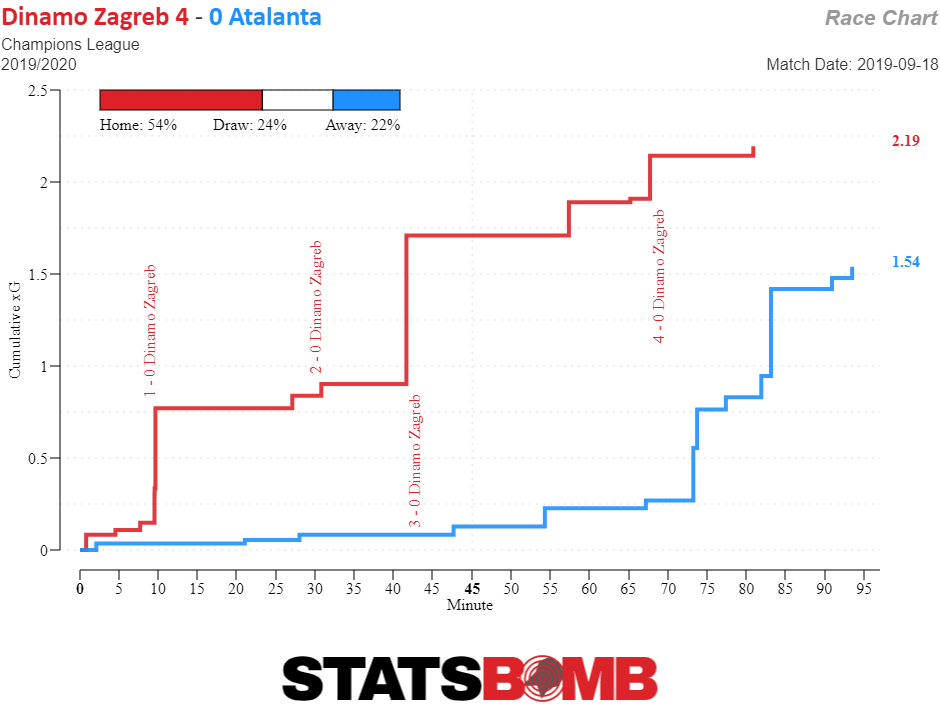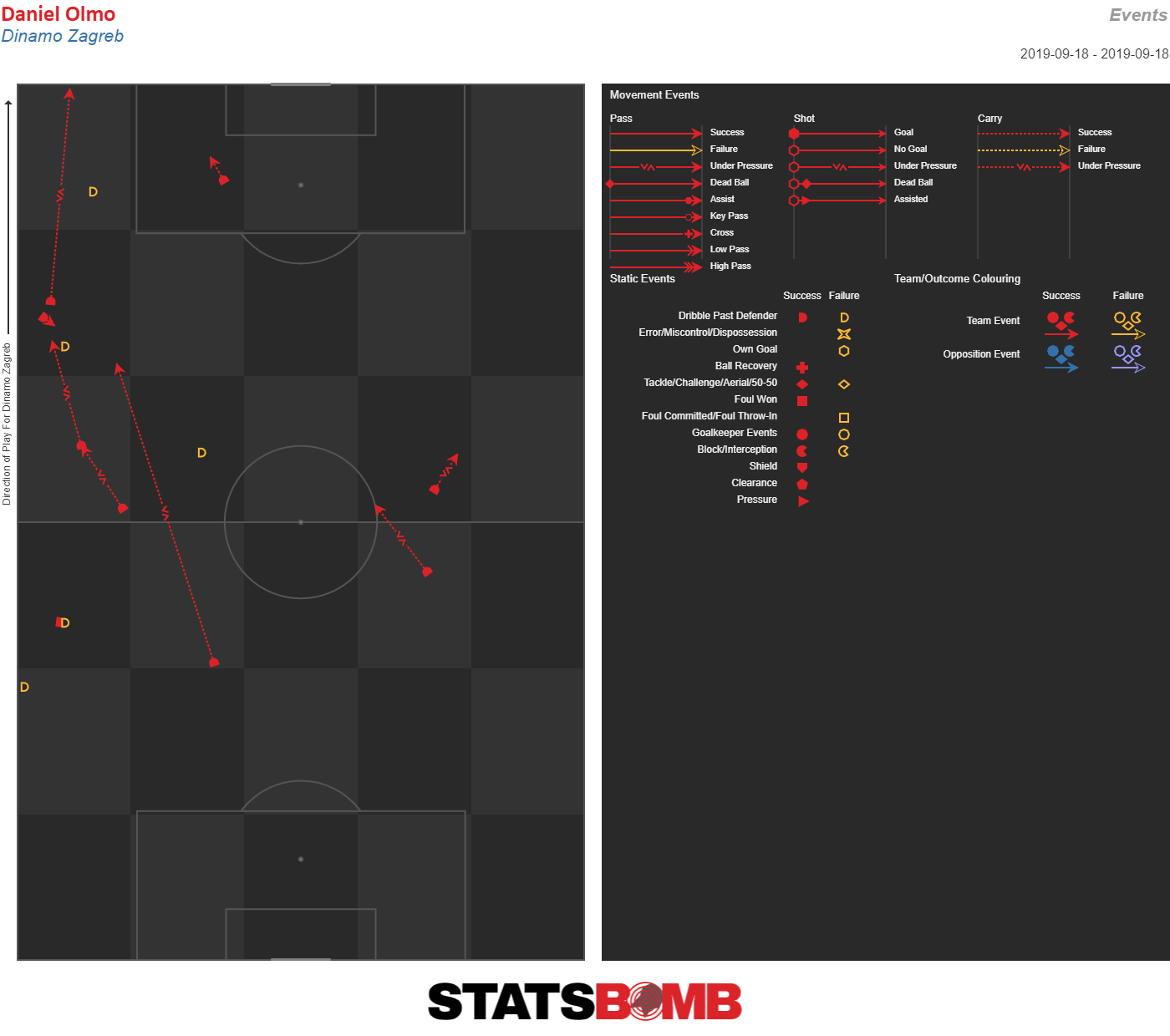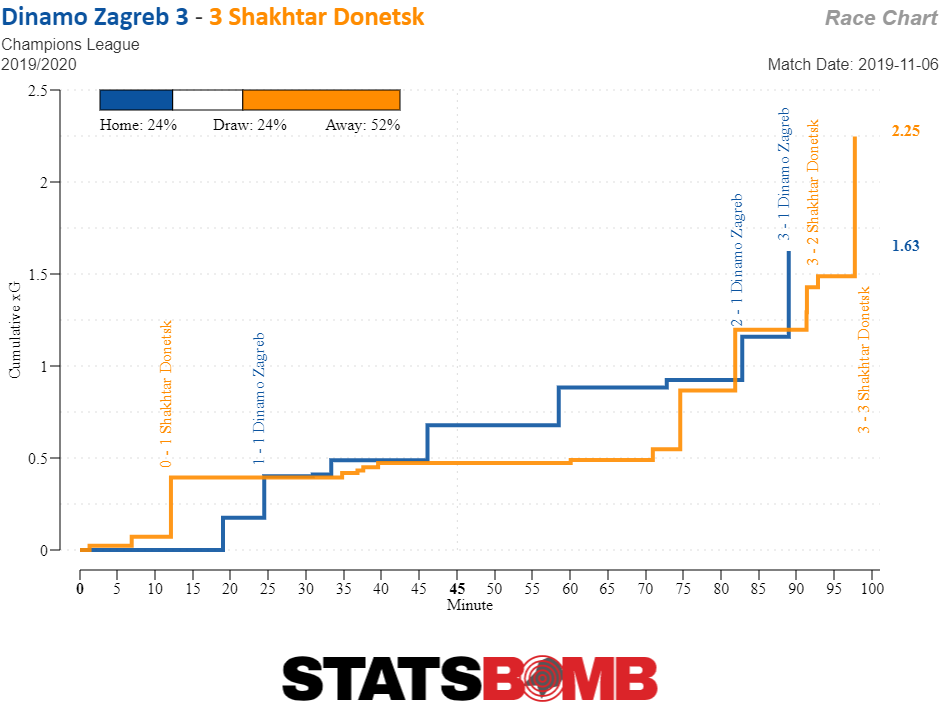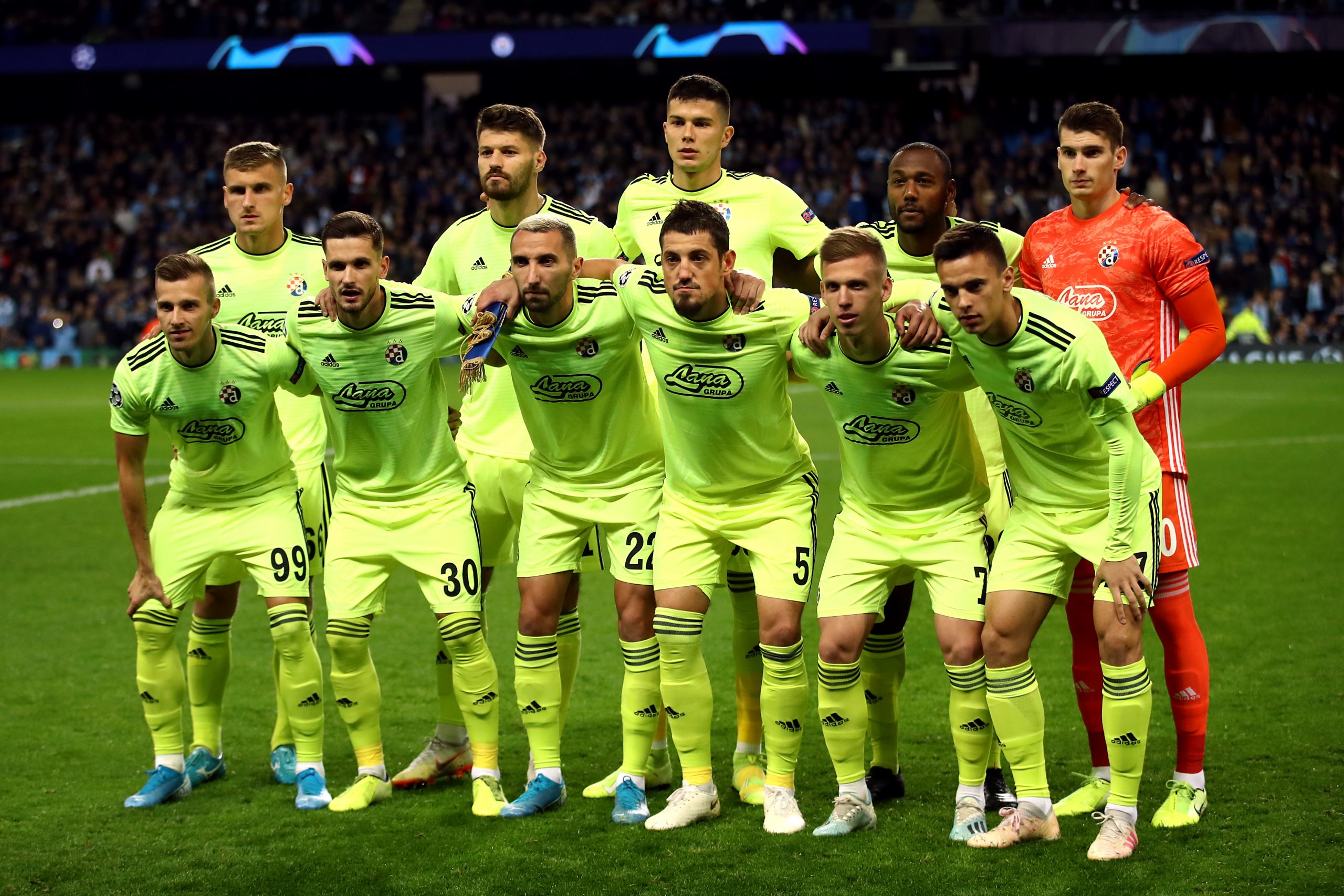There’s no denying that Dinamo Zagreb have the ability to surprise. Manchester United fans may remember when Dinamo came to town to face the defending European Champions, only to hold the Red Devils to a goalless draw in the first round of the 1999–2000 Champions League. Arsenal went to Zagreb for their opening game in the 2015–2016 Champions League, only to see Olivier Giroud sent off after 40 minutes, and their team lose to a side that hadn’t won a UCL match in their last 15 attempts. And this season, the unexpected high-fliers from Italy, a quick and ruthless Atalanta, were destroyed by Dinamo in Zagreb, 4–0. The Croatian champions even held Shakhtar Donetsk to back-to-back draws, ensuring they remain in third—and even in contention for second and a spot in the Round of 16—should they secure a shock victory while Atalanta come away with a win in Ukraine. This could finally be the year that, for the first time in history, Dinamo advance to the knockout stages.. Their only significant European achievement is having won the Inter-Cities Fair Cup in 1966–67, a tournament so complicated to explain that it’s best just to say that UEFA does not even consider clubs’ honors to be part of their European record. The club certainly have enough domestic honors to brag about, with 20 Croatian League titles and 15 Cup wins, as well as 9 Yugoslav titles and 8 Yugoslav Cup trophies, though it must be said that most of those came during the time of the Kingdom of Yugoslavia rather than the post-World War II federation, in which the clubs from Belgrade dominated. Considering this history, and assuming Shakhtar won’t manage to beat Atalanta, a win for Dinamo against Manchester City would be a massive triumph for the club on the international stage. And City have nothing to play for. Shakhtar can’t reach first in Group C, no matter how hard they try. Meanwhile, Atalanta could still grab second with a win in Ukraine, while their opponents want to hold their place, which might lead to a boring draw and the chance for Dinamo to sneak into second. The question is, even if City don’t field their best side, is there any chance the hosts can take all three points? Only if Dinamo have one more surprise left in them. The first surprise came in that first round against Atalanta, when they played a 3-5-2 for the first time since Nenad Bjelica took over at the start of the 2018–19 season, and they executed it perfectly. The side Bjelica fielded ensured Atalanta could not gain the numerical advantage in the midfield, something the Goddesses must do to play their own brand of attacking football. Instead, Dinamo were the aggressors, surprising everyone with the way they dominated the match.  Bjelica’s stroke of brilliance was playing Mislav Oršić as a second striker rather than his usual place out wide. His constant runs behind the defense created many problems for Gian Piero Gasperini's side. Surprisingly, Oršić didn’t actually touch the ball much, and when he did, nothing particularly magical occurred. He executed very few passes, dribbles, or even duels. Everything he did, he did without the ball—except for scoring three goals from six shots that is. Dani Olmo, on the other hand, not only didn't score or provide an assist, he only had a single shot. Yet he was absolutely dominant otherwise. He attempted 14 dribbles, succeeding on nine of them—more than Slavia Praha, Valencia and Zenit St. Petersburg average per match—creating a numerical advantage for his team in dangerous areas. Atalanta couldn't deal with him at all, which showed in the fact they chose to foul him more than any other Dinamo player.
Bjelica’s stroke of brilliance was playing Mislav Oršić as a second striker rather than his usual place out wide. His constant runs behind the defense created many problems for Gian Piero Gasperini's side. Surprisingly, Oršić didn’t actually touch the ball much, and when he did, nothing particularly magical occurred. He executed very few passes, dribbles, or even duels. Everything he did, he did without the ball—except for scoring three goals from six shots that is. Dani Olmo, on the other hand, not only didn't score or provide an assist, he only had a single shot. Yet he was absolutely dominant otherwise. He attempted 14 dribbles, succeeding on nine of them—more than Slavia Praha, Valencia and Zenit St. Petersburg average per match—creating a numerical advantage for his team in dangerous areas. Atalanta couldn't deal with him at all, which showed in the fact they chose to foul him more than any other Dinamo player.  The first match against Atalanta aside, Dinamo’s primary problem is similar to that of other teams from smaller leagues trying to advance in the Champions League (or even secure a place in the next Europa League round). Dinamo dominate their domestic league, nine points clear at the top of the table and although they’ve not managed to beat Hajduk Split, their rivals and the team currently in second, they do have double the expected goal difference. This highlights the problem. Dinamo dominate bad teams but when they face more difficult opposition, the side retreats into a defensive formation, sitting deep and attempting to adapt to their opponents in order to counter specific threats. Although they usually begin in the same 3-5-2 formation used against Atalanta, attempting to overload the midfield, this plan is no longer a surprise, and hasn’t worked as well in their other four matches. In the fifth and most recent game, Atalanta certainly knew what Bjelica was going to throw at them, and Gasperini was ready: he turned Dinamo’s approach in the first leg against them, suffocating their midfield, a task made easier by holding midfielder Nikola Moro being unable to play due to a red card suspension. Dinamo’s determination to nullify other teams’ midfields, stems in part from the fact that it is their own central midfield that is the weakest part of the squad. Luka Ivanušec, only 21 years old, hasn’t managed to establish himself domestically in the few Croatian League games he’s played, so it’s really no surprise that he could not hold off the Italian side. Even if Moro had been present, neither have the needed characteristics of a defensive midfielder, which leaves the team vulnerable when playing against superior opposition, at least opposition properly prepared for what they’re about to face. And yet. And yet. There are those two games against Shakhtar where Dinamo came away with a point from each, and played well to boot. They could have, and possibly should have, come away from a win from at least one of those games. In Ukraine they had the better of the chances., while at home they led a close match for well over 90 minutes before giving up two stoppage time goals in what was a truly wild finish.
The first match against Atalanta aside, Dinamo’s primary problem is similar to that of other teams from smaller leagues trying to advance in the Champions League (or even secure a place in the next Europa League round). Dinamo dominate their domestic league, nine points clear at the top of the table and although they’ve not managed to beat Hajduk Split, their rivals and the team currently in second, they do have double the expected goal difference. This highlights the problem. Dinamo dominate bad teams but when they face more difficult opposition, the side retreats into a defensive formation, sitting deep and attempting to adapt to their opponents in order to counter specific threats. Although they usually begin in the same 3-5-2 formation used against Atalanta, attempting to overload the midfield, this plan is no longer a surprise, and hasn’t worked as well in their other four matches. In the fifth and most recent game, Atalanta certainly knew what Bjelica was going to throw at them, and Gasperini was ready: he turned Dinamo’s approach in the first leg against them, suffocating their midfield, a task made easier by holding midfielder Nikola Moro being unable to play due to a red card suspension. Dinamo’s determination to nullify other teams’ midfields, stems in part from the fact that it is their own central midfield that is the weakest part of the squad. Luka Ivanušec, only 21 years old, hasn’t managed to establish himself domestically in the few Croatian League games he’s played, so it’s really no surprise that he could not hold off the Italian side. Even if Moro had been present, neither have the needed characteristics of a defensive midfielder, which leaves the team vulnerable when playing against superior opposition, at least opposition properly prepared for what they’re about to face. And yet. And yet. There are those two games against Shakhtar where Dinamo came away with a point from each, and played well to boot. They could have, and possibly should have, come away from a win from at least one of those games. In Ukraine they had the better of the chances., while at home they led a close match for well over 90 minutes before giving up two stoppage time goals in what was a truly wild finish. 
 Given how those matches played out though, they don’t exactly inspire confidence. Blowing late leads (and in both matches conceding buckets of xG in the last 20 minutes) will give supporters the willies no matter what the final xG tally says. No wonder the fans have more questions than answers, which means they’re likely to keep the paper bags handy when City come to town. Those questions primarily boil down to whether Olmo and Oršić step up. While both lack certain aspects that would make them a complete player on the world stage—hence why they’re living in Zagreb—they both manage to do their job perfectly. Olmo, who recently earned his first call-up to the Spanish national team, plays between the lines, forcing Dinamo’s opponents to focus on him. When he does his job right, his teammates can seize the opportunity to threaten the goal. Meanwhile, as he was against Atalanta, Oršić is the main counterattacking threat, although he is obviously more easily subdued by better opposition. Finally, when Moro is having a good game (as was the case at Shakhtar), the holding midfielder can provide the team with an engine, dropping back and starting almost every attack and sending up long passes to both wings. Again, though, this is something that superior teams can adapt to after facing—or just watching—this side in action. When Shakhtar came to Zagreb, they simply avoided the central part of the pitch, focusing mostly on the wings where they had a 2 v 1 advantage. This also managed to shut down Moro’s ability to send his own players the passes they needed. Bjelica adapted, changing the formation during the game and gaining back some measure of control. It seemed like Dinamo would win, making a Europa League appearance, at the very least, almost certain. However, Shakhtar’s two goals in stoppage time complicated that narrative. Was it just one of those things, a fluke to write off and move on from, or did the match take a physical toll, leaving Dinamo unable to hang with their opponents deep in added time? Or, most worrisome of all did it simply show that the side doesn’t have the necessary maturity to to close the deal in Europe’s most important competition? While it’s possible that maturity—something the youngsters have yet to gain, and that Oršić has yet to refine, given that this is his first season in Champions League—is what stops Dinamo from beating City. But it’ll more likely come down to something that’s easily revealed by facts and figures. In the first tie, Bjelica quickly realized he needed to shift the formation into extreme-defense mode, taking on a 5-3-2 and bunkering down. No surprise, then, that Manchester City absolutely dominated possession and had 20 shots. Still, despite the ugly looking shot chart,it took more than an hour for Raheem Sterling to get his team on the board, and it was only in the last minute that City put the game to bed.
Given how those matches played out though, they don’t exactly inspire confidence. Blowing late leads (and in both matches conceding buckets of xG in the last 20 minutes) will give supporters the willies no matter what the final xG tally says. No wonder the fans have more questions than answers, which means they’re likely to keep the paper bags handy when City come to town. Those questions primarily boil down to whether Olmo and Oršić step up. While both lack certain aspects that would make them a complete player on the world stage—hence why they’re living in Zagreb—they both manage to do their job perfectly. Olmo, who recently earned his first call-up to the Spanish national team, plays between the lines, forcing Dinamo’s opponents to focus on him. When he does his job right, his teammates can seize the opportunity to threaten the goal. Meanwhile, as he was against Atalanta, Oršić is the main counterattacking threat, although he is obviously more easily subdued by better opposition. Finally, when Moro is having a good game (as was the case at Shakhtar), the holding midfielder can provide the team with an engine, dropping back and starting almost every attack and sending up long passes to both wings. Again, though, this is something that superior teams can adapt to after facing—or just watching—this side in action. When Shakhtar came to Zagreb, they simply avoided the central part of the pitch, focusing mostly on the wings where they had a 2 v 1 advantage. This also managed to shut down Moro’s ability to send his own players the passes they needed. Bjelica adapted, changing the formation during the game and gaining back some measure of control. It seemed like Dinamo would win, making a Europa League appearance, at the very least, almost certain. However, Shakhtar’s two goals in stoppage time complicated that narrative. Was it just one of those things, a fluke to write off and move on from, or did the match take a physical toll, leaving Dinamo unable to hang with their opponents deep in added time? Or, most worrisome of all did it simply show that the side doesn’t have the necessary maturity to to close the deal in Europe’s most important competition? While it’s possible that maturity—something the youngsters have yet to gain, and that Oršić has yet to refine, given that this is his first season in Champions League—is what stops Dinamo from beating City. But it’ll more likely come down to something that’s easily revealed by facts and figures. In the first tie, Bjelica quickly realized he needed to shift the formation into extreme-defense mode, taking on a 5-3-2 and bunkering down. No surprise, then, that Manchester City absolutely dominated possession and had 20 shots. Still, despite the ugly looking shot chart,it took more than an hour for Raheem Sterling to get his team on the board, and it was only in the last minute that City put the game to bed.  Perhaps, then, the surprise will be that City don’t give a rat’s tushie about actually scoring, and will be content to pass the ball around while Dinamo hunker down, allowing the hosts a point. Or maybe Bjelica will provide the surprise, realizing that his team needs to do more than capture a point to continue playing in Europe, given Shakhtar have the advantage due to their three goals at Zagreb. If that’s the case, his side will likely approach this game like they did Atalanta, and if so, Manchester City are likely to fight back, if for no reason but the sake of their pride, and the game could turn into an unexpected thriller. That surprise, of seeing this Dinamo team actually opening up, of going full throttle in attack because they know they’ve got nothing left to lose, would be the best surprise of all. Header image courtesy of the Press Association
Perhaps, then, the surprise will be that City don’t give a rat’s tushie about actually scoring, and will be content to pass the ball around while Dinamo hunker down, allowing the hosts a point. Or maybe Bjelica will provide the surprise, realizing that his team needs to do more than capture a point to continue playing in Europe, given Shakhtar have the advantage due to their three goals at Zagreb. If that’s the case, his side will likely approach this game like they did Atalanta, and if so, Manchester City are likely to fight back, if for no reason but the sake of their pride, and the game could turn into an unexpected thriller. That surprise, of seeing this Dinamo team actually opening up, of going full throttle in attack because they know they’ve got nothing left to lose, would be the best surprise of all. Header image courtesy of the Press Association
2019
Can Dinamo Zagreb pull off a historic Champions League surprise?
By admin
|
December 10, 2019
